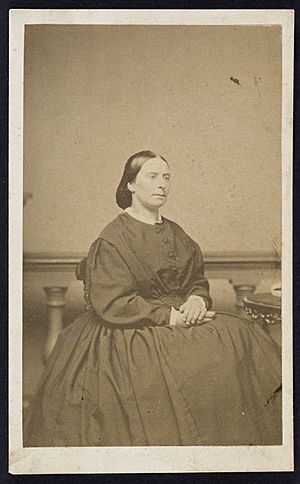Elizabeth Stack facts for kids
Elizabeth (Eliza) Rachel Jean Stack (born Jones; 1829 – 1919) was an important person in New Zealand's history. She was a settler, meaning she helped establish a new community. She was also an author who wrote about her experiences, and a botanist, someone who studies plants.
Contents
Early Life and Journey to New Zealand
Eliza Stack was born in Anglesey, Wales, in 1829. Her father, Humphrey Jones, worked for the government, managing customs at Holyhead. Eliza was the youngest of nine children. When she was fourteen, both her parents passed away, and she went to live with different relatives.
In 1856, her brother, Humphrey Jones, returned from the Crimean War. He was a military officer who managed supplies. He was then told to move to New Zealand. Since his wife had recently died, he asked Eliza to come with him.
In 1857, Eliza and her brother sailed to New Zealand on a ship called the Dinapore. The journey was long and took four months. Eliza wrote that it was "long and tedious." To pass the time, she enjoyed listening to the daughters of Andrew Buchanan play music.
Exploring New Zealand's Plants
Eliza Stack loved collecting plants. As she traveled around New Zealand, she gathered many different types of ferns, lichens, seaweed, and mosses.
Collecting Ferns on Waiheke Island
Soon after arriving in New Zealand, Eliza explored Waiheke Island with her sister-in-law, Emma Jones. They collected many ferns. Eliza wrote that the ferns and nikau palms made the forest look "quite tropical." She and Emma found "a great variety of small ferns" for their collections.
Discovering Plants with Dr. Sinclair
In 1858, Eliza met Dr. Andrew Sinclair, who was also very interested in plants. He offered to help her identify the plants she had collected.
Later that year, Eliza visited the famous Pink and White Terraces. These were beautiful natural terraces formed by hot springs. She was very proud to have climbed to the top of Te Tarata, one of the terraces. There, she collected special mosses and ferns that grew in the warm, moist air. Some of the mosses were very tall, and she found three types of ferns growing right next to the boiling water.
Building a Collection
Eliza also collected other natural items for her 'museum,' such as weta (a type of insect), lizards, and stalactites (rock formations from caves). In 1859, both Dr. Sinclair and Captain Haultain (likely Theodore Haultain) offered to help her organize her fern collection.
Eliza's journal often describes her trips to find ferns and mosses. She often went with her brother Humphrey and his wife Emma. On one trip in the Remutaka Ranges in 1859, she met two botanists from England. They shared some plant samples with Eliza's group and exchanged other specimens.
Family Life and Later Years
On January 28, 1861, Eliza married James West Stack, a missionary. Their wedding was held at St Stephens Chapel in Auckland. Bishop Selwyn performed the ceremony.
The Stacks lived in Kaiapoi until 1870, when their home was destroyed by fire. After that, they moved to Christchurch. They had seven children: three daughters and four sons.
Later, their income decreased, so they moved to Duvauchelle Bay in 1880. In 1895, Eliza and James visited Eliza's brother in Bordighera, Italy, for a year.
In 1898, the Stacks left New Zealand for good. They first lived with Eliza's brother in Bordighera. After he passed away in 1907, they moved to Worthing, England. Eliza died in Worthing on December 2, 1919, at the age of 90. This was just seven weeks after her husband passed away. Both Eliza and James are buried in the Christ Church graveyard in Worthing.


